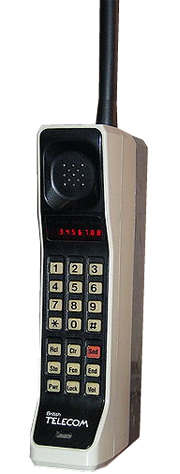1G-Analog:
- Introduced in year 1987 by Telecom, Australia received its first cellular mobile phone network utilizing a 1G analog system.
- 1G uses AMPS (Advanced Mobile Phone System) is a voice only network operating on the 800 MHz band.
- AMPS operated in the same manner as a regular radio transmission where 800 MHz bans was split into a number of channels (395 voice, 21 control) via FDMA (Frequency Division Multiple Access).
- Each channel was 30 KHz wide.
- The maximum number of mobile phone users per cell tower was only 395.
- An AMPS user could connect to a cell tower as far as signal could be transmitted (often >40km depending on the terrain (land)).
2G-Digital:
- Fast forward to 1993 Telecom, introduces the digital network. Security being the most important to motivators.
- With this new technology came many of the services text messaging, multimedia messaging, Internet access and also introduced us to the SIM card.
- This new digital network is called GSM-Global System for Mobile communication.
- The radio frequency band utilized by the GSM is the 900 MHz spectrum and later introduced on the 1800 MHz band.
- TDMA- Time Division Multiple Access is the backbone for the GSM technology.
- The FDMA component splits the 900 MHz band into 124 channels that are 200 KHz wide.
- The time component then comes into play in which each channel is split into eight 0.577us bursts, significantly increasing the maximum number of users at any one time.
- Aside from more users per cell tower, the digital network offers many other features.
- Digital encryption (64-bit A5/ 1 stream cipher).
- SMS text messaging.
- Caller ID and other similar network features.
- GSM is limited severely in range. The TDMA technology behind the 2G network means that if a mobile phone cannot respond within its given timeslot (0.577us bursts) the phone tower will drop you and begin handling another call.
- Aside from this, packet data transmission rates on GSM are extremely slow.
To overcome these two problems we're going to introduce two new networks - CDMA and EDGE.
CDMA
Code Division Multiple Access. This branch of 2G was introduced by Telstra in September 1999 as a replacement for customers who could receive a good signal on AMPS, but were outside GSM's limited range. The extended range is achieved by removing the 'time' based multiplexing with a code-based multiplexing. A lower frequency band (800MHz) also assisted in range by reduced path loss and attenuation.
EDGE
Enhanced Data Rates for GSM Evolution. GSM introduced a GPRS based packet data network in 2001, with a max speed of around 60-80kbps (downlink), equating to a download speed of 10kB/s - slightly faster than dial-up.EDGE was later introduced as a bolt-on protocol (no new technology was required) increasing the data rate of the 2G network to around 237kbps (29kB/s).
3G- The Mobile Broadband Revolution:
- Introducing the 2100 MHz network. Three mobile in conjugation with Telstra brought the 3G standard to life in 2005, servicing major metropolitan areas.
- The 2100 MHz combined with a 900 MHz network forms the basis of all non-Telstra mobile broadband services, servicing around 94% of Australian residences.
- The 3G standard utilises a new technology called UMTS as its core network architecture - Universal Mobile Telecommunications System.
- This network combines aspects of the 2G network with some new technology and protocols to deliver a significantly faster data rate.
- UMTS employs a protocol called HSPA - High Speed Packet Access, which is a combination of HSDPA (downlink) and HSUPA (uplink) protocols.
- The Telstra HSDPA network supports category 10 devices (speeds up to 14.4Mbps down) however most devices are only capable of category 7/8 transmission (7.2Mbps down), and its HSUPA network supports category 6 (5.76Mbps up).
- The only major limitation of the 3G network is, not surprisingly, coverage. As stated earlier the 2100MHz network is available to around 50% of Australia's population and when combined with a 900MHz UMTS network available to about 94%.
- As expected, the higher 2100MHz component suffers far more attenuation and FSPL and is often considered a 'short range' mobile network which is why a lower 900MHz network is required to service many regional and rural areas.
- The 4G network is based on LTE-Advanced - 3GPP Long Term Evolution. LTE is a series of upgrades to existing UMTS technology and will be rolled out on Telstra's existing 1800MHz frequency band.
- This new network boosts peak downloads speeds up to 100Mbps and 50Mbps upload.
- 4G uses a technology called MIMO "Multiple In Multiple Out" where your modem uses two separate antennas at once to deliver super fast speeds.
- It is important to know MIMO is switched on and off by the modem. The decision whether to use MIMO is negotiated with the cell tower, whereby the quality of the received and transmitted signals are assessed.
Notes:














